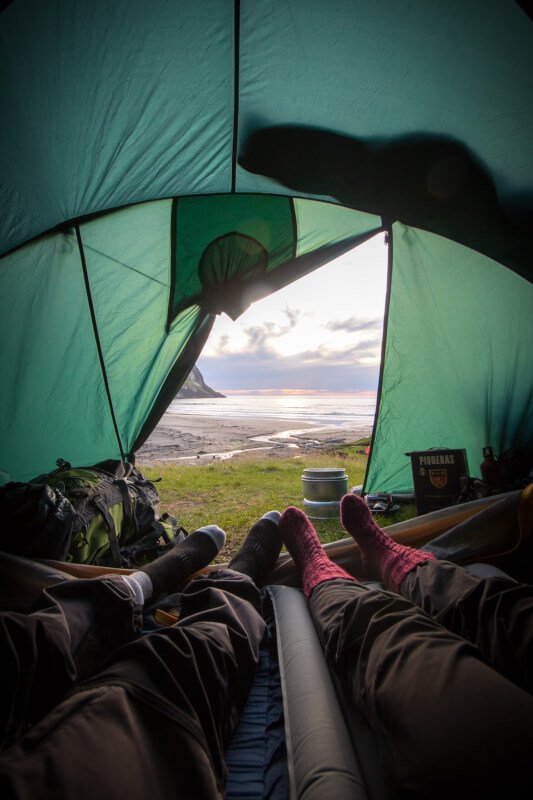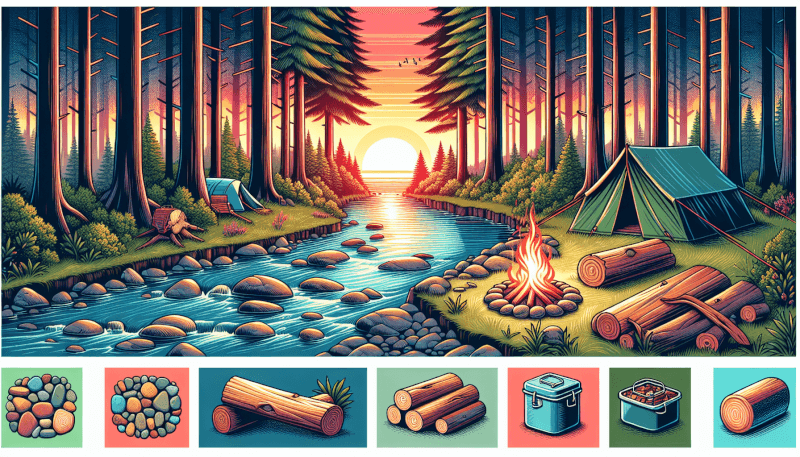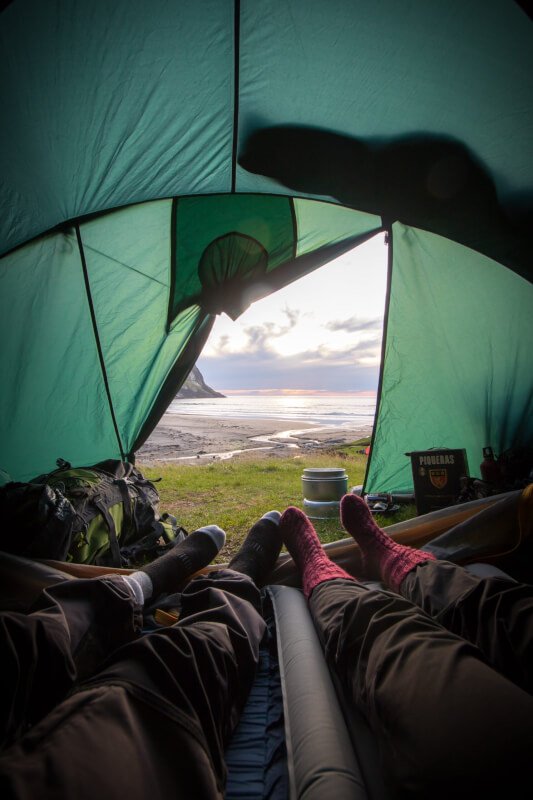Imagine yourself surrounded by the beauty of nature, the sound of chirping birds, and the gentle rustle of leaves. You’ve embarked on a camping adventure, but as a beginner, you find yourself unsure of where to start. Look no further, for this article will serve as your ultimate guide to setting up a campsite. Whether you are a first-time camper or simply in need of a refresher, we’ll take you through the essentials, from choosing the perfect location to setting up your tent and creating a cozy outdoor haven. Get ready to embark on an unforgettable camping experience and connect with the great outdoors like never before.
Choosing the Perfect Campsite
Considering Your Destination
When choosing a campsite, the first thing you need to consider is your destination. Think about the type of experience you’re looking for. Do you want to be nestled in the tranquility of a dense forest, or do you prefer to camp near a beautiful lake? Knowing your destination will help narrow down your options and make it easier to find the perfect campsite.
Researching Local Regulations and Permits
Before setting off on your camping adventure, it’s crucial to research the local regulations and permits. Different areas may have specific rules regarding camping, such as designated camping areas or restrictions on open fires. By familiarizing yourself with the regulations and obtaining any necessary permits, you can ensure a smooth and hassle-free camping experience.
Evaluating Accessibility
Considering the accessibility of your chosen campsite is essential, especially if you have specific needs or limitations. If you’re camping with young children or elderly family members, you may want to choose a campsite that is easily accessible and not too far from parking areas or restrooms. On the other hand, if you’re seeking a more remote and adventurous experience, you might opt for a campsite that requires hiking or backpacking.
Assessing Available Amenities
The available amenities at a campsite can greatly impact your camping experience. Some campsites offer amenities like flush toilets, showers, picnic tables, and even electrical hookups. These amenities can provide convenience and comfort during your trip. However, if you prefer a more rustic experience, you may choose a campsite with limited amenities to immerse yourself in nature. Consider what amenities are important to you and choose a campsite accordingly.
Essential Gear and Equipment
Tent Selection and Set Up
Choosing the right tent is crucial for a comfortable and enjoyable camping experience. Consider factors such as size, weather resistance, and ease of set up. Look for a tent that accommodates the number of people camping, has a sturdy frame, and is made from durable materials. When setting up your tent, ensure you have a level and clear area, follow the manufacturer’s instructions, and secure the tent properly to withstand any weather conditions.
Sleeping Gear Essentials
A good night’s sleep is essential when camping. Invest in comfortable sleeping gear, such as sleeping bags, sleeping pads, and pillows. Choose a sleeping bag appropriate for the weather conditions you’ll be camping in. Sleeping pads provide insulation and cushioning, while pillows add extra comfort. Don’t forget to pack extra blankets or quilts for colder nights.
Cooking Equipment and Utensils
Food is an integral part of the camping experience, so having the right cooking equipment and utensils is important. A portable stove or grill, along with cookware like pots, pans, and a kettle, will make meal preparation easier. Don’t forget to pack essential utensils like camping knives, cutting boards, and serving utensils. Consider the type of meals you plan to cook and ensure you have the appropriate tools.
Lighting and Navigation Tools
Having proper lighting and navigation tools is crucial for safety and convenience during your camping trip. Pack headlamps or flashlights to navigate in the dark, especially when going to the restroom or exploring at night. Consider bringing a lantern to light up your campsite and create a cozy ambiance. Additionally, it’s a good idea to have a compass, map, or GPS device to help you navigate trails and unfamiliar areas.

Campsite Safety Measures
Fire Safety Precautions
When camping, fire safety should be a top priority. Before starting a campfire, make sure to check if fires are allowed and if any restrictions are in place. Always build fires in designated fire rings or pits and keep a safe distance between the fire and flammable materials. Never leave a campfire unattended, and ensure it is fully extinguished before leaving or going to sleep. Keep a bucket of water or a fire extinguisher nearby in case of emergencies.
Wildlife Awareness and Food Storage
Camping often brings you closer to nature, including wildlife. It’s important to be aware of the wildlife in the area and take proper precautions to avoid any unwanted encounters. Store food securely in bear-resistant containers or bear bags, away from your sleeping area. Dispose of food waste properly to avoid attracting wildlife to your campsite. Follow local regulations and guidelines regarding wildlife encounters, and never approach or feed any wild animals.
First Aid Kit and Emergency Contacts
Accidents can happen even in the safest of environments, so it’s crucial to be prepared. Always have a well-stocked first aid kit on hand that includes essentials such as bandages, antiseptic ointment, pain relievers, and any necessary prescription medications. Familiarize yourself with the location’s emergency contacts, including the nearest hospital, park rangers, or emergency services. Share your camping plans and itinerary with a trusted friend or family member, so they can assist in case of an emergency.
Weather Conditions and Emergency Plans
Keep a close eye on weather conditions leading up to and during your camping trip. Pack appropriate clothing and gear for different weather scenarios, such as rain gear, extra layers, and sun protection. Familiarize yourself with the signs of severe weather and have a plan in place in case of emergencies. Identify the closest shelter or safe location and be prepared to evacuate if necessary. Stay informed by monitoring weather forecasts and park or campground alerts.
Setting Up Camp Basics
Clearing and Leveling the Ground
Before pitching your tent, it’s essential to clear and level the ground. Remove any twigs, rocks, or debris that may cause discomfort or damage to your tent. Clearing the ground also helps eliminate potential tripping hazards. Once the area is clear, use a camping shovel or your feet to level the ground, ensuring there are no protruding roots or rocks that could disrupt your sleep.
Pitching the Tent Properly
Properly pitching your tent ensures stability and protection from the elements. Start by laying out the tent footprint or groundsheet to provide an extra layer of insulation and protection against moisture. Follow the tent manufacturer’s instructions to assemble the poles and attach them to the tent body. Stake down the corners and any guy lines to secure the tent against wind. Check that the rainfly is properly attached to provide additional weather protection.
Setting Up Sleeping Arrangement
Create a comfortable sleeping arrangement by setting up your sleeping gear properly. Place sleeping pads or mattresses inside the tent to provide insulation and cushioning against the ground. Arrange sleeping bags or bedding in a way that maximizes space and minimizes drafts. If camping with a partner, consider using double sleeping bags or zipping two single sleeping bags together for a cozy and romantic camping experience!
Organizing Personal Belongings
Efficiently organizing your personal belongings will make your camping experience more enjoyable. Utilize camping-specific storage solutions such as duffel bags, camping bins, or hanging organizers to keep items easily accessible and prevent clutter. Separate essentials like toiletries, cooking utensils, and clothes into different compartments to maintain cleanliness and orderliness. Keep frequently used items within reach, and pack less frequently needed items away to maximize space.

Campfire Building and Cooking
Choosing the Right Fire Ring or Pit
Building a campfire is a classic camping activity, but it’s essential to choose the right fire ring or pit. Look for a designated fire ring within the campsite or campground, as these are specifically designed to contain the fire safely. If no designated fire ring is available, choose a spot at least 15 feet away from tents, trees, and any flammable materials. Clear the area around the fire pit and ensure there are no overhanging branches or dry vegetation nearby.
Gathering Firewood and Fire Starter
Before starting a campfire, gather an appropriate amount of firewood. Look for fallen branches or purchase firewood from authorized vendors to prevent damage to the local ecosystem. Choose dry firewood, as wet or green wood produces more smoke and is harder to burn. Additionally, gather fire starter materials such as newspaper, dry leaves, or commercially available fire starters to help ignite the fire quickly and easily.
Building and Managing the Campfire
Building a campfire requires proper technique to ensure it is safe and sustainable. Start by creating a small teepee-like structure using small twigs or kindling in the center of the fire ring. Gradually add larger sticks and logs to the teepee as the fire grows. Ensure there is enough airflow for the fire by leaving gaps between the logs. As the fire burns, regularly add firewood to maintain a steady flame. Always monitor the fire and keep a bucket of water or sand nearby for emergencies.
Preparing and Cooking Meals
Cooking meals over a campfire can be a delicious and enjoyable experience. Plan your meals in advance and prepare ingredients that are easy to cook over an open flame. Aluminum foil can be used for cooking vegetables, fish, or even desserts. Consider using a portable grill or a tripod grill for more elaborate meals. Don’t forget essential cooking tools such as tongs, spatulas, and oven mitts. Practice proper food safety and hygiene by washing hands, using separate cutting boards for raw and cooked foods, and ensuring meat is cooked thoroughly.
Hygiene and Waste Management
Choosing a Suitable Campsite Toilet Option
Proper bathroom hygiene and waste management are crucial for both your comfort and the environment. Some campsites offer restroom facilities with flushing toilets, while others may have pit or vault toilets. If no facilities are available, consider using portable camping toilets or trowels to dig catholes for human waste disposal. Pack biodegradable toilet paper and always bury waste at least 200 feet away from water sources. Leave the area as clean as you found it to minimize your impact on the environment.
Maintaining Personal Hygiene
Maintaining personal hygiene while camping is important for your comfort and overall well-being. Bring biodegradable soap, toothpaste, and other hygiene products to minimize environmental impact. Choose unscented products to reduce attracting wildlife. Make use of portable camping showers or natural water sources for bathing. If water is scarce, use wet wipes or dry shampoo to freshen up. Always practice leave no trace principles by disposing of hygiene products properly and carrying out any waste.
Proper Waste Disposal and Litter Management
Proper waste disposal and litter management are essential for keeping the campsite clean and preserving the environment. Dispose of trash, food waste, and packaging in designated trash bins or take it with you when leaving. Always properly secure trash bags to prevent animal scavenging. Avoid littering and pick up any litter you come across, even if it’s not your own. Use reusable containers and avoid single-use plastics to minimize waste generation.
Leave No Trace Principles
Adhering to leave no trace principles is essential for preserving the beauty of nature and ensuring a sustainable camping experience. Remember to leave the campsite in the same condition as you found it, if not better. Minimize your impact by staying on established trails, using designated campsites, and avoiding fragile vegetation. Respect wildlife by observing from a distance and not feeding or disturbing them. Leave natural and cultural artifacts untouched and educate others about the importance of leaving no trace.

Outdoor Cooking and Meal Planning
Meal Planning and Food Storage
Meal planning is an important aspect of camping to ensure you have delicious and nutritious meals during your adventure. Plan meals that are easy to prepare with minimal cooking equipment. Consider packing non-perishable food items like canned goods, dried fruits, and energy bars. If you plan to bring perishable items, use coolers or food storage containers with ice packs to keep them fresh. Organize your food supplies in a way that avoids cross-contamination and makes meal preparation more efficient.
Cooking Techniques and Equipment
When cooking outdoors, familiarize yourself with different cooking techniques to diversify your camping meals. Besides traditional campfire cooking, try using a portable stove or Dutch oven for more controlled cooking. Experiment with grilling, foil packet meals, and stir-frying using a cast-iron skillet. Consider investing in camping-specific cookware and utensils that are designed for outdoor cooking. Remember to always practice fire safety and ensure your cooking area is clear of any flammable materials.
Campfire Recipes and Tips
Cooking over a campfire provides a unique culinary experience. Explore campfire recipes that are easy to prepare and require simple ingredients. Some classic favorites include s’mores, foil-wrapped hobo dinners, and campfire popcorn. Try roasting vegetables on skewers or cooking fresh fish over an open flame. Don’t forget to bring seasonings, spices, and condiments to add flavor to your meals. Get creative with your cooking and enjoy the delicious flavors that campfire cooking can bring.
Cleaning Up and Waste Disposal
After enjoying a delicious meal, it’s essential to clean up properly and dispose of waste responsibly. Pack biodegradable soap and a scrub brush to clean cookware and utensils. Use hot water and a small amount of soap to wash dishes thoroughly. Dispose of gray water at least 200 feet away from water sources, following local regulations. Properly store leftover food to prevent attracting wildlife. Remember to pack away all cooking equipment and leave the cooking area clean and free of debris.
Adventure Activities and Recreation
Hiking and Trail Etiquette
Camping provides a wonderful opportunity to explore nature and embark on exciting hiking adventures. Before setting off on a hike, familiarize yourself with trail maps, difficulty levels, and any necessary permits or regulations. Follow trail etiquette by staying on marked trails, yielding to uphill hikers, and respecting the environment. Be prepared with appropriate hiking gear, including sturdy footwear, hats, sunscreen, and plenty of water. Leave no trace by packing out what you pack in and refraining from disturbing wildlife.
Fishing, Swimming, and Water Activities
If your campsite is near a lake, river, or other bodies of water, take advantage of the recreational opportunities they offer. Fishing can be a relaxing and rewarding activity for campers. Check local regulations, obtain any necessary permits, and practice catch and release to preserve fish populations. If swimming is allowed, enjoy cooling off in the water, but remember to practice water safety. Always wear life jackets when boating or engaging in water sports to ensure your safety.
Wildlife Watching and Bird Identification
Camping is a great opportunity to observe wildlife in their natural habitats. Explore the local flora and fauna, and identify different bird species. Consider bringing field guides or using smartphone apps to help with bird identification. Observe wildlife from a safe distance and avoid disturbing their natural behaviors. Practice responsible wildlife watching by not feeding or approaching animals. Bring binoculars or a camera to capture those special moments without disturbing the animals or their habitats.
Leave No Trace Principles
When engaging in adventure activities and recreation while camping, it’s essential to abide by leave no trace principles. Respect the natural environment by staying on designated trails and avoiding shortcuts that may cause erosion or harm to vegetation. Minimize your impact on wildlife by observing from a distance and not disrupting their habitats. Dispose of waste properly, including fishing lines and hooks, to prevent harm to animals. By following leave no trace principles, you can ensure the environment remains pristine for future campers.

Nighttime Comfort and Safety
Setting Up Sleeping Gear and Comfort
A good night’s sleep is essential for a successful camping trip. Set up your sleeping gear to maximize comfort and safety. Use sleeping pads or mattresses to provide insulation and cushioning against the ground. Choose a sleeping bag appropriate for the weather and consider layering with blankets for additional warmth. Pillows, earplugs, and eye masks can help improve sleep quality. Secure the tent properly to prevent drafts or moisture from entering, ensuring a cozy and restful night’s sleep.
Using Proper Lighting Solutions
When it comes to nighttime camping, proper lighting is key to safety and convenience. Headlamps or flashlights are essential for navigating around the campsite, especially when going to the restroom or searching for items in the dark. Hang lanterns or string lights to provide ambient lighting and create a cozy atmosphere. Avoid using bright lights that may disturb other campers or wildlife. Consider using red or amber lights, which are less disruptive to sleep patterns and provide a softer glow.
Avoiding Common Nighttime Hazards
Camping at night brings its own set of challenges and hazards. Be mindful of potential dangers and take precautions to mitigate them. Always keep your camping area organized to minimize trip hazards. Secure food and trash properly to avoid attracting wildlife to your sleeping area. Familiarize yourself with the campsite layout and locate emergency exits or evacuation routes. Be cautious of campfire sparks and embers, and always extinguish the fire completely before going to sleep.
Staying Warm and Dry
Staying warm and dry is essential to ensure a comfortable and enjoyable camping experience, especially during colder nights or inclement weather. Bring appropriate clothing layers, including thermal or moisture-wicking base layers, insulating mid-layers, and weather-resistant outer layers. Pack extra blankets or quilts to add warmth to your sleeping setup. Consider using a waterproof tent footprint or groundsheet to prevent moisture from seeping in. It’s also advisable to bring tarps or rain flys for additional protection against rain or snow.
Breaking Down the Campsite
Properly Cleaning the Campsite
As your camping trip comes to an end, it’s essential to leave the campsite clean and free of any trace of your presence. Collect and dispose of any trash or waste properly, following the campsite’s guidelines. Inspect the area for small items like bottle caps or food scraps that could attract wildlife. Use a camping shovel or trowel to fill in any catholes that were dug for waste disposal. Before leaving, rake or brush away any signs of your campsite, ensuring it looks as undisturbed as possible.
Disassembling and Packing Gear
Disassembling and packing your gear efficiently will make the camp breakdown process smoother. Follow the manufacturer’s instructions to disassemble your tent and pack it carefully to minimize damage. Separate dirty and wet gear from clean items to prevent cross-contamination. Pack your gear in a logical order, ensuring frequently needed items are easily accessible. Consider using storage bags or containers to keep smaller items organized. When packing, double-check for any forgotten items, especially in hard-to-see places like under the picnic table or behind rocks.
Double-checking for Forgotten Items
Before leaving the campsite, it’s important to double-check for any forgotten items. Walk around the campsite, inspecting every nook and cranny. Look under picnic tables, in fire rings, and inside tents for any small or hidden items that may have been missed during the packing process. Check restrooms or shower areas for personal belongings. Have a checklist of essential items to ensure nothing is left behind, such as tent stakes, cooking utensils, or personal items like cell phones or sunglasses.
Leaving No Trace Behind
The final step in breaking down your campsite is leaving no trace behind. Adhering to leave no trace principles is crucial for the maintenance and preservation of the environment. Remove all personal belongings, trash, and food waste from the campsite. Dispose of trash in designated bins or pack it out with you. Restore the campsite to its natural state by smoothing out disturbed ground or rearranging rocks. By leaving no trace behind, you ensure that future campers can enjoy the beauty of nature just as you did.



